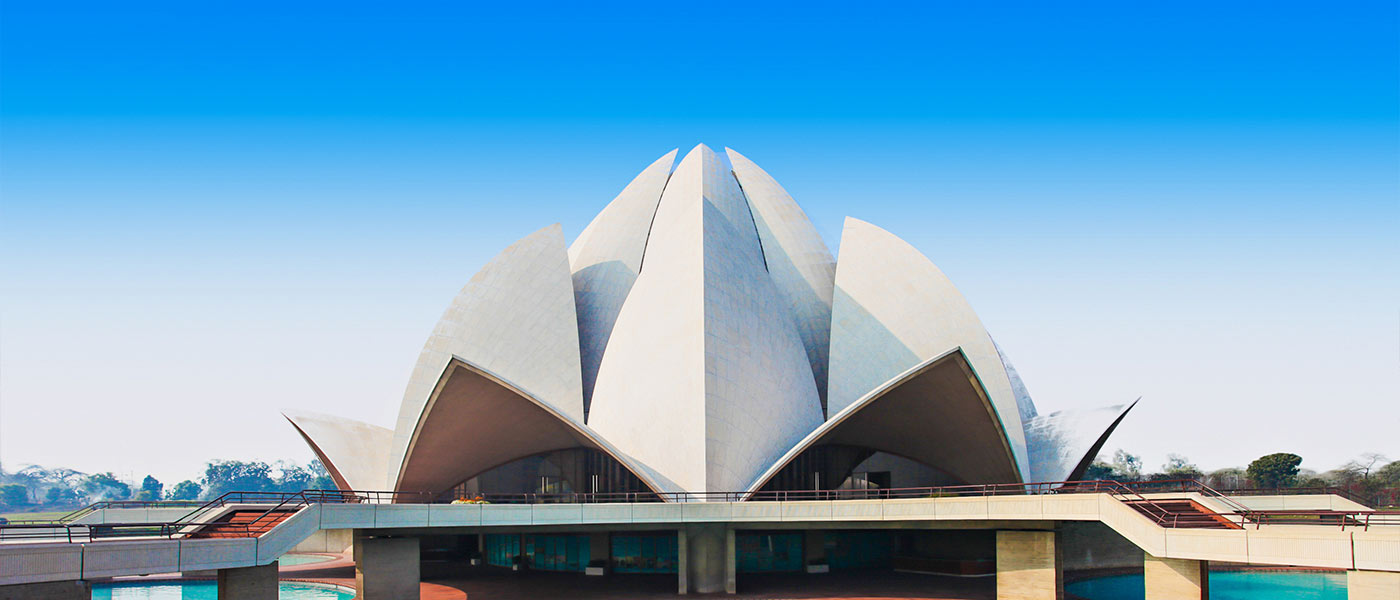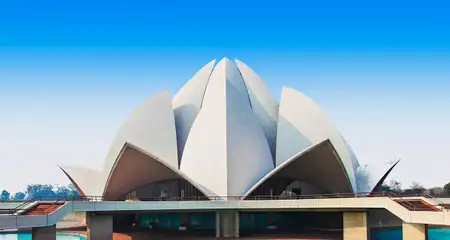The Lotus Temple (also known as Kamal Mandir) in Delhi is a matchless architectural marvel and one of the prime tourist attractions of the National Capital. Shaped in the form of a spectacular lotus with white petals, it makes for a break-taking sight and attracts countless visitors throughout the year. Unlike most other places of worship, this temple or Bahai House of Worship does not allow ritualistic ceremonies and has no fixed pattern to conduct worship. A glorious symbol of oneness, this place of worship must be on your itinerary when planning a trip and booking your hotels in Delhi.
Want to know more? Here is everything you need to know about the Lotus Temple in Delhi, including its history, architecture, timings, and other details.
Lotus Temple Information:
| Location | Lotus Temple Road, Kalkaji |
| Timings | October to March – 9:30 am to 5:30 pm, April to September – 9:30 am to 7:00 pm; *Closed on Mondays |
| Entry Fee | Free |
| Camera | No camera charges, but you need to take special permission for photography |
| Nearest Metro Station | Kalkaji Mandir |
| Status | Bahai House of Worship |
| Prayer Timings | 10 AM, 12 PM, 3 PM, 5 PM |
| Best Season to Visit | October to March |
| Established in | 1986 |
| Area | 26 acres |
| Material Used | Marble |
| Architect | Fariborz Sahba |
| Cost of Construction | 10 million dollars |
Lotus Temple: How to Reach
Lotus Temple is easily accessible as there are multiple options that connect the temple to the city. Some of them are:
- By Road: There are 8-10 bus routes by DTC that pass near the Lotus Temple. There are options for cabs and autorickshaws as well.
- By Metro: Lotus Temple’s nearest metro station is Kalkaji with a distance of 500m from the temple.
- By Train: New Delhi Railway Station is the nearest to the temple.
- By Air: Indira Gandhi International Airport is the nearest airport to the temple.
- Places to Stay nearby: Hotels near Lotus Temple
Lotus Temple: History
The Lotus Temple Delhi is a Bahai House of Worship, also known as Mashriqu’l-Adhkár, opened to the public in December 1986. Like all other Bahai temples, it is also dedicated to the oneness of religions and humanity. Followers of all religions are welcome to gather here to pray, worship, and read their scriptures. The Lotus Temple in Delhi is touted as one of the seven major Bahai Houses of Worship located across the world and the only one in Asia.
Lotus Temple: What to do
The Lotus Temple offers four main or ‘core’ activities to anyone who might be interested in pursuing them. These activities also provide you with information about Lotus Temple and Bahai teachings. These include:
- Children’s Classes: These classes aim at imbibing values such as generosity, justice, kindness, unity, courage, truthfulness, reliance on God, and service to humanity through Bahai teachings.
- Junior Youth Classes: These classes seek to develop spiritual and intellectual capacities in children aged 11-14 years.
- Devotional Meetings: These sessions are aimed at creating a loving and harmonious environment within the community.
- Study Circles: These meetings are aimed at making a comprehensive study of Bahai Writings, Prayer, and Life and Death, and hence create a spiritual consciousness among the people.
Architecture
Surrounded by lush green landscaped gardens, this lotus-inspired structure spreads across 26 acres of land. Made using white marble sourced from Greece, it comprises of 27 petals in the free-standing state. These petals are organized in groups of three to lend the structure a nine-sided circular shape, as has been indicated in the Bahai scripture. There are nine entrances that open to a huge central hall, which is about 40 meters in height. The temple has a seating capacity of 1300 people and can accommodate 2500 people at a time.
There are no altars or pulpits inside the Lotus Temple, which is a common feature of all Bahai Houses of Worship. The interiors are devoid of any statues, pictures, or image as well. An eye-catching feature of the temple is the nine pools of water located around the petals. They give the impression of a half-bloomed lotus in a water body and the whole structure looks spectacular when illuminated in the night.
This temple was designed by Fariborz Sahba, an Iranian-American architect while the structural design was done by Flint and Neill, a UK firm. Larsen & Toubro Limited’s ECC Construction Group undertook the construction work of the temple and completed it at a cost of 10 million dollars.
Lotus Temple: Today
Today, the Lotus Temple is undoubtedly one of the most popular religious as well as tourist attractions in Delhi. By the end of 2001, the temple had drawn more than 70 million visitors from across the globe, making it one of the most visited structures in the world. As per the Government of India, by April 2014, the temple had received more than 100 million visitors. The temple is frequently featured in films, publications, and television productions and has also won many awards for its spellbinding architecture.
Lesser Known Facts about Lotus Temple
- With around 4.5 million visitors per year, it is among the most visited structures in the world.
- The temple is featured on a ₹6.50 postage stamp in India.
- Fariborz Sahba chose the lotus symbol as it’s a common symbol in Hinduism, Jainism, Buddhism, and Islam.
- It is the first temple in the national capital that makes use of solar power.
- Ardishír Rustampúr, a Bahai follower from Hyderabad in the Sindh province of Pakistan, donated his entire savings to fund the land purchase of the temple.
Attractions near Lotus Temple
- Kalkaji Devi Temple (600 m) – Kalkaji Mandir is a temple dedicated to Goddess Kali. Kalkaji Mandir is one of the busiest Hindu temples in Delhi. Kalkaji metro station is also the nearest metro station to Lotus Temple.
- ISKCON Temple (2.6 km) – Sri Sri Radha Parthasarathi Mandir, generally known as the ISKCON Delhi temple, is a well-known Vaishnav temple of Lord Krishna and Radharani in the form of Radha Parthasarathi.
- Humayun’s Tomb (6.5 km) – Humayun’s Tomb is another UNESCO World Heritage Site and a remarkable example of Mughal architecture. It is the tomb of the Mughal Emperor Humayun and is surrounded by beautiful gardens.
- India Gate (8.6 km) – India Gate is a war memorial located in the heart of New Delhi. The monument is surrounded by vast lawns, making it a popular spot for picnics and evening strolls.
- Qutub Minar (9.8 km) – The Qutub Minar is a UNESCO World Heritage Site and one of the most famous historical landmarks in Delhi. It’s a towering minaret made of red sandstone and marble, standing at a height of 73 meters. There are a lot of commuting options from Lotus Temple to Qutub Minar via bus, metro, or cab.
- Lodhi Tomb (10 km) – Lodhi Gardens is a historical park with beautifully landscaped gardens and historical monuments from the 15th century Sayyid and Lodhi dynasties.
- Akshardham Temple(13.1 km) –The Akshardham Temple is a modern Hindu temple complex known for its stunning architecture and intricate carvings.
In the busy national capital of India, the Lotus Temple (Kamal Mandir) is an oasis of serenity where you can meditate and pray at peace.It’s one of the must places to visit in Delhi. At the same time, this is where you can witness one of the most stupendous structures in the world. Why not plan a visit to the Lotus Temple, Delhi and spend some time soaking in its beauty and peaceful vibes?
FAQs
Q. What is Lotus Temple famous for?
A. The temple is famous for its fully blossomed lotus design by the Iranian architect. The Lotus Temple in New Delhi is one of 7 temples of the Baha’i faith in the world.
Q. What is the best time to visit Lotus Temple in Delhi?
A. Lotus Temple timings in Delhi are 9 AM to 5 PM all days except Monday as it remains closed. Lotus Temple ticket price is free and the best season is October to March with the pleasant weather.
Q. What is the Lotus Temple closing time?
A. The Lotus Temple closing time is different for summers and winters. In summer the temple closes at 7 pm whereas in winter the temple closes at 5:30 pm.
Q. Can we sit in Lotus Temple?
A. Yes, Sitting in Lotus Temple is allowed and people come here only for their peace of mind and sit for hours and enjoy the beauty of this place.
Q. Do we have to remove shoes in Lotus Temple?
A. Shoes are not allowed on the grass or the temple premise; hence, you must remove your shoes and deposit them in the shoe room.
Q. Can we click pictures in Lotus Temple?
A. Visitors are allowed to take Lotus Temple photos from outside of the temple’s exterior, including the beautiful lotus-shaped structure and its surroundings. However, photography is strictly prohibited inside the temple’s main hall, where visitors are required to maintain silence and show respect for the temple’s spiritual significance.
Q. Is there any dress code in Lotus Temple?
A. The dress code for visiting the Lotus Temple in Delhi is modest and conservative. Visitors are expected to dress in clothing that covers their shoulders, arms, and legs. Tight-fitting or revealing clothing is not allowed inside the temple premises.
Q. Where is Lotus Temple?
A. Lotus Temple is located in Delhi.
Q. Who built Lotus Temple?
A. The Lotus temple was built by Fariborz Sahba, who comes from an Iranian-American background.
Q. Lotus Temple is made up of which rock?
A. Marble used for the temple comes from Mount Penteli in Greece. This Pentelikon marble is also used for other Baha’i houses of worship.



























